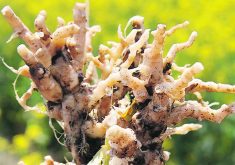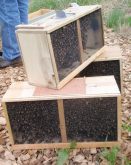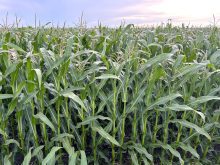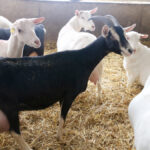A study of two Alberta watersheds will help livestock producers improve their manure management practices and improve water quality.
Run-off control from a dairy barn or a feedlot needs to be controlled, especially if the run-off is in hydrologically active zones, said Janna Casson, a soil and water specialist with Alberta Agriculture. You have got to be worried about point-source pollution, regardless of where you are.
Alberta Agriculture researchers recently shared their findings from a study of the Whelp Creek watershed, located just west of Lacombe. The study, which began in 2007 and will wrap up next year, is examining what management practices offer the best economic and environmental benefits. About 20 producers are involved with the project, which is being replicated at the Indian Farm Creek watershed near Pincher Creek.
Read Also

Canola’s clubroot success story
At one time, scientists, agronomists and growers were extremely worried clubroot would spread across the Prairies and devastate Canada’s canola industry.
The Whelp Creek watershed covers about 4,500 hectares and is typical for the central Alberta region.
Within the watershed, it s primarily agricultural activity there are 60 homesteads with 50 active producers, said Andrea Kalischuk, head of the water quality section with Alberta Agriculture in Lethbridge.
Most of the land is devoted to annual crops, although some is perennial forage. Livestock production includes 10 dairies, seven beef operations, and one poultry operation. Both manure and commercial fertilizers are used in the area. Liquid dairy manure is the main manure source, and is often surface applied and then incorporated, with little injection.
Managing nutrient run-off
Croplands that have received manure tend to have high runoffs of phosphorus and leaching of nitrogen into shallow groundwater.
The soil tests of phosphorus ranged from 30 to about 75 parts per million in the surface soil, said Barry Olson, a research scientist in the soil and water quality section of Alberta Agriculture in Lethbridge.
This level is high, but not considered excessive. Fields that have not received manure had phosphorus levels from about 18 to 30 parts per million.
Liquid manure has a nitrogen-phosphorus ratio that matches what crops need, as compared to solid beef manure, which has a higher phosphorus-to-nitrogen ratio that can bump phosphorus rates in the soil.
The team studied several nutrient management sites. They used soil testing to make fertilizer recommendations and examined the total nitrogen, phosphorus, ammonia and moisture in the manure.
We make some assumptions about nitrogen and phosphorus availability in the manure in order to come up with an application rate in order to meet nitrogen or phosphorus of what the crop needs, said Olson.
The manure was appl ied using appropriate methods with proper setbacks from drainage channels, and then a water-sampling unit was used to monitor water quality and track flowing water.
Researchers also looked at the interaction of surface and groundwater, said Kristen Lorenz, groundwater specialist with Alberta Agriculture in Edmonton.
Contamination of one of these sources can impact the other, said Lorenz. If you re looking at surface water, phosphorus tends to be the nutrient of concern, and if you re looking at groundwater, nitrogen is the nutrient of concern. But you have to look at both of them when you re considering beneficial management practices.
Many springs throughout the Whelp Creek watershed interact with groundwater in some way. Two buried channels in the watershed contain large amounts of gravel, which helps to create high groundwater yields.
Unsaturated soils or soils that do not have groundwater in them are important because contaminants can move down through the soils and reach shallow groundwater, said Lorenz.
If the shallow groundwater is contaminated, nutrients can spread into deeper groundwater resources or to surface water, she said.
There are several wetlands in the Whelp Creek area. Some are temporary or seasonal and can be dry for years. But these temporary wetlands act as a recharge for groundwater.
Wetlands are like sponges, so they store water during precipitation and run-off events and then that water can be slowly released and recharge shallow groundwater, said Lorenz.
———
Youhavegottobeworriedaboutpointsourcepollution,regardlessofwhereyouare.
JANNA CASSON















